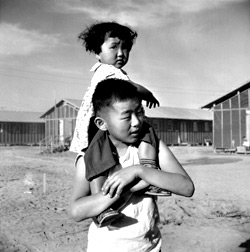How not to structure your documentary on an already well-known subject: Spend the hour’s first 45 minutes tastefully recapitulating the familiar (in this case, the unlawful and disgraceful internment of some 120,000 Japanese-Americans during World War II); then introduce five minutes of news; then go back to the same faded snapshots, Cheney-esque government propaganda newsreels, and white-haired elders talking of reconciliation and forgiveness. One of those elders, California artist Ruth Okimoto, will be at the screenings Friday and Saturday for a chat with the directors and a panel discussion; those surely would be vivid history lessons for your kid, regardless of your family’s ethnic heritage. But here’s the lead that filmmakers Joe Fox and James Nubile have buried in their TV educational special. One internment facility, near Poston, Arizona, was apparently used in a scheme by the Bureau of Indian Affairs to artificially boost its wartime population (by more than 17,000 internees) to justify federal irrigation spending, and put those internees to work (for free) to build the roads and electricity that would also later benefit the Colorado River Indian Reservation. That’s right: One oppressed and forcibly relocated minority group was essentially used as slave labor to improve the lives of another oppressed and forcibly relocated minority group. Says an elder of the Colorado River tribes in the film, “From their suffering, we gained a lot.” When the Supreme Court finally ruled in 1944 that Japanese-Americans had been illegally confined, Indians moved into their old barracks. Today, the surrounding land appears green and prosperous. I’d love to know how the area compares to other reservations (where poverty, disease, and alcoholism are all too common), and to the descendants of the internees. But that would require another film with better editing.
Passing Poston
Our government oppresses one minority for the benefit of another.








